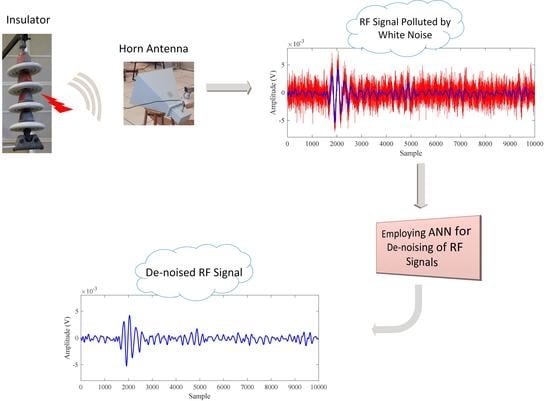Denoising of Radio Frequency Partial Discharge Signals Using Artificial Neural Network
Abstract
:1. Introduction
2. Laboratory Setup for PD Signals Measurement
3. Denoising of Partial Discharge RF Signals
3.1. Peak of Signal to Noise Ratio
3.2. Factors for Evaluation of Denoising Algorithms
- The Electric Charge Error (QE):
- Root Mean Square Error (RMSE):
- Correlation Coefficient (CC):
- Signal-to-Noise Ratio—Denoised (SNRD):
3.3. Considering Discrete Wavelet Transform for Denoising of RF Signal
3.3.1. Basic Principles
3.3.2. Mother Wavelet (MW) Selection
3.3.3. Thresholding Procedure (TP)
- The original noise-free signal is decomposed to reach the predefined level, J, resulting in AJ and D1-J sub-bands.
- The mentioned procedure above is repeated for the noisy signal, in order to achieve NAJ and ND1-J sub-bands as well.
- The coefficients of NAJ are kept completely, and all components of ND1 are set on zero. Next, threshold values, λJ, are estimated for each level of ND2-J, and the coefficients are then thresholded using (6)
3.4. Proposed Method
3.4.1. Artificial Neural Network Curve Fitting
3.4.2. Suitable Number of Neurons for the Structure of the ANN
3.4.3. Optimization Methods
3.4.4. Effect of Sampling Rate on the Performance of the Proposed Method
3.4.5. Full Procedure of the Proposed Method
- Normalizing the RF signal bywhere X and XN are the main RF signal and normalized one, respectively.
- Dividing MDW into the pre-defined BDW with 10,000 samples lengths each.
- Separately denoising each BDW, using 100 neurons in the ANN structure.
- Connecting all BDWs together to attain the complete denoised MDW RF signal.
- Obtaining the real RF signal by multiplying the maximum value, achieved in Step 1, by the signal denoised in Step 4.
4. Results and Discussions
4.1. Effectiveness of the Proposed ANN-Based Denoisng Technique
4.2. Consideration of Denoising for Combining Two RF Signals
5. Conclusions
Author Contributions
Funding
Conflicts of Interest
References
- Hussein, R.; Shaban, K.B.; El-Hag, A. Denoising different types of acoustic partial discharge signals using power spectral subtraction. High Volt. 2018, 1, 44–50. [Google Scholar] [CrossRef]
- Ghorat, M.; Gharehpetian, G.B.; Latifi, H.; Hejazi, M.A. A new partial discharge signal denoising algorithm based on adaptive dual-tree complex wavelet transform. IEEE Trans. Inst. Meas. 2018, 67, 2262–2272. [Google Scholar] [CrossRef]
- Carvalho, A.T.; Lima, A.C.S.; Cunha, C.F.F.C.; Petraglia, M. Identification of partial discharges immersed in noise in large hydro-generators based on improved wavelet selection methods. Measurement 2015, 75, 122–133. [Google Scholar] [CrossRef]
- Kopf, U.; Feser, K. Rejection of narrow-band noise and repetitive pulses in on-site PD measurements. IEEE Trans. Dielectr. Electr. Insul. 1995, 6, 1180–1191. [Google Scholar] [CrossRef]
- Sriram, S.; Nitin, S.; Prabhu, K.; Bastiaans, M. Signal denoising techniques for partial discharge measurements. IEEE Trans. Dielectr. Electr. Insul. 2005, 12, 1182–1191. [Google Scholar] [CrossRef]
- Ashtiani, M.B.; Shahrtash, S.M. Feature-oriented denoising of partial discharge signals employing mathematical morphology filters. IEEE Trans. Dielectr. Electr. Insul. 2012, 19, 2128–2136. [Google Scholar] [CrossRef]
- Soltani, A.A.; Shahrtash, S.M. Self-adaptive morphological filter for noise reduction of partial discharge signals. In Proceedings of the 33rd Power System Conference, Tehran, Iran, 22–24 October 2018. [Google Scholar]
- Wu, Z.; Huang, N.E. Ensemble empirical mode decomposition: A noise-assisted data analysis method. Adv. Adapt. Data Anal. 2009, 1, 1–41. [Google Scholar] [CrossRef]
- Jin, T.; Li, Q.; Mohamed, A.M. A novel adaptive EEMD method for switchgear partial discharge signal denoising. IEEE Access 2019, 7, 58139–58147. [Google Scholar] [CrossRef]
- Hussein, R.; Shaban, K.B.; El-Hag, A. Energy conservation based thresholding for effective wavelet denoising of partial discharge signals. IET Sci. Meas. Technol. 2016, 10, 813–822. [Google Scholar] [CrossRef]
- Anjum, S.; Jayaram, S.; El-Hag, A.; Jahromi, A.N. Detection and classification of defects in ceramic insulators using RF antenna. IEEE Trans. Dielectr. Electr. Insul. 2017, 24, 183–190. [Google Scholar] [CrossRef]
- Najafipour, A.; Babaee, A.; Shahrtash, S.M. Comparing the trustworthiness of signal-to-noise ratio and peak signal-to-noise ratio in processing noisy partial discharge signals. IET Sci. Meas. Technol. 2012, 7, 112–118. [Google Scholar] [CrossRef]
- Mortazavi, S.; Shahrtash, S. Comparing denoising performance of DWT, WPT, SWT AND DT-CWT for partial discharge signals. In Proceedings of the 43rd International Universities Power Engineering Conference, Padova, Italy, 1–4 September 2008. [Google Scholar]
- Li, J.; Jiang, T.; Grzybowski, S.; Cheng, C. Scale dependent wavelet selection for denoising of partial discharge detection. IEEE Trans. Dielectr. Electr. Insul. 2010, 17, 126–137. [Google Scholar] [CrossRef]
- Budiman, F.N.; Khan, Y.; Malik, N.H.; Al-Arainy, A.A.; Beroual, A. Utilization of artificial neural network for the estimation of size and position of metallic particle adhering to spacer in GIS. IEEE Trans. Dielectr. Electr. Insul. 2013, 20, 2143–2151. [Google Scholar] [CrossRef]















| Optimization Method | PSNR | ||
|---|---|---|---|
| 1 | 1.5 | 2 | |
| Levenberg–Marquardt | 0.04102 | 0.02899 | 0.02258 |
| Bayesian Regularization | 0.04387 | 0.02966 | 0.02263 |
| BFGS Quasi-Newton | 0.04236 | 0.03041 | 0.02261 |
| Resilient Back Propagation | 0.04296 | 0.02918 | 0.02283 |
| Scaled Conjugate Gradient | 0.04165 | 0.03039 | 0.02276 |
© 2019 by the authors. Licensee MDPI, Basel, Switzerland. This article is an open access article distributed under the terms and conditions of the Creative Commons Attribution (CC BY) license (http://creativecommons.org/licenses/by/4.0/).
Share and Cite
Soltani, A.A.; El-Hag, A. Denoising of Radio Frequency Partial Discharge Signals Using Artificial Neural Network. Energies 2019, 12, 3485. https://doi.org/10.3390/en12183485
Soltani AA, El-Hag A. Denoising of Radio Frequency Partial Discharge Signals Using Artificial Neural Network. Energies. 2019; 12(18):3485. https://doi.org/10.3390/en12183485
Chicago/Turabian StyleSoltani, Amir Abbas, and Ayman El-Hag. 2019. "Denoising of Radio Frequency Partial Discharge Signals Using Artificial Neural Network" Energies 12, no. 18: 3485. https://doi.org/10.3390/en12183485







